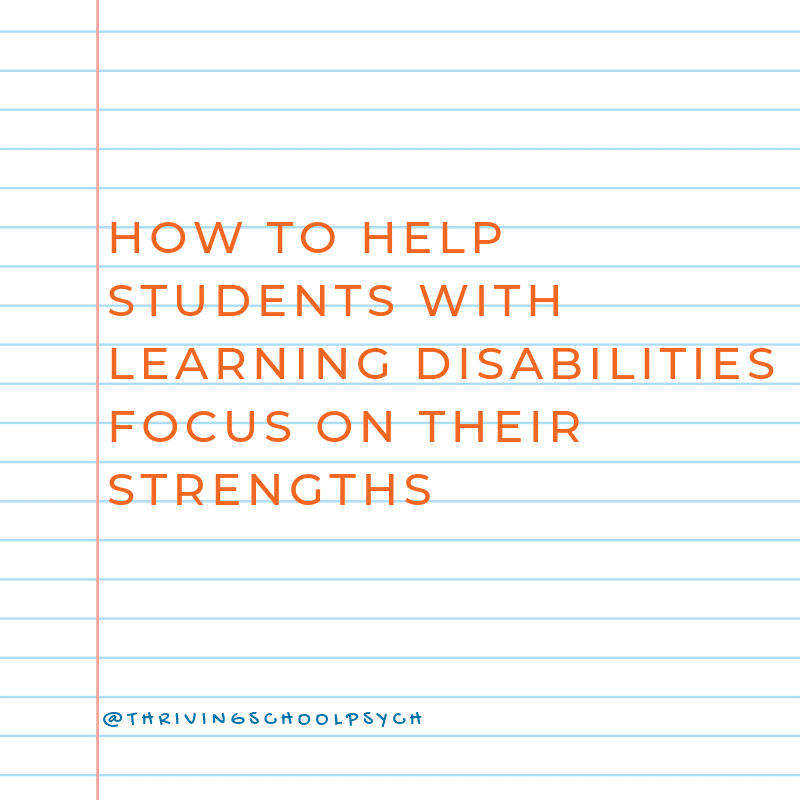
We’ve all been there. As school psychologists, we know all too well the feeling right before we have to tell a child that she has a learning disability.
I recently had an interesting experience with a student that made me pause and reflect on the best way to talk to kids and families about what a learning disability is.
I know deep down that we can empower students with learning disabilities with the language we use and the way we teach and guide them. But I wanted science to back me up…
So…I dove into the research on strength-based language and reducing stigma in using labels with kids with disabilities.
And then, I got to cross a vision-board item off my vision board.
I got to write a guest post for The Greater Good Science Center’s newsletter! If you don’t already know them, get ready to be a Superfan, because they are at the forefront of making positive psychology science accessible to everyone. Real talk? I am having a real nerdy fangirl moment over here about sharing what we school psychologists do to support our students with learning disabilities.
Check out the article “How to Help Students with Learning Disabilities Focus on their Strengths” here to read about the surprising reaction I got to telling a girl she had Dyslexia, and learn 3 research-based strategies for tapping into our students’ potential.
Oh, and be sure to see the shameless plug for our fine profession of school psychology! I’m starting School Psychology Awareness Week 2 months early. 🙂
I’d love to hear from you all as well…how do you explain learning disabilities to students and parents with a strength-based lens?

Rebecca- great article!! And thank you for turning me on to the greater good science center! The communication of our findings is the best and most important job we have as school psychologists. It’s so healing for people to find out why their child is struggling and to get a road-map to move in a more positive direction. I’ve found that parents and children get so excited to hear about how Richard Branson’s disability MADE his career, for example. I have different metaphors for different disabilities (ie how a cup can only retain so much water and those with executive function deficits just need more frequent data dumps). This is my most favorite part of my job!
Thanks for sharing, Laura! You will LOVE the Greater Good Science Center. They’re a treasure trove of awesome. 🙂
Awesome read and advice for informing parents and children during initial eligibility meetings!
One way that I explain learning disabilities to students and parents is by referring to the bell curve. I am a fan of visuals and with the plethora of paperwork that the parent(s) will receive, a visual is always helpful for quick reference. For each individual evaluation, I color code areas of strength and growth along the curve.
I also speak directly from my report to highlight those areas during my explanations. For example, in my reports, I would state that “John Doe exceled at recreating puzzles and manipulating visual stimuli. During the _ subtest, John Doe did…” John Doe could benefit from additional practice in…” It’s kind of like a “sandwiching technique” where I speak to the strengths that I observed during the testing session(s) first and then lead into where interventions could be helpful.
I also share that the beauty of assessments is that it informs everyone involved of what the student is currently capable of and where the student truly needs additional support. A lot of understanding comes from how the information is conveyed and my goal is to speak and write in a easily understandable language for my audience.
Thanks for sharing, Andrea! The sandwiching technique is really powerful, as it normalizes that there are strengths and areas of growth. And yes, I love the visual aid during meetings!
Hi!! In your article, you referenced using, with this student, a visual aid of her brain in pictures. I am very curious about what this visual is, and how you use it with elementary age students?? Mind sharing?
Thank you!
Kathryn
Hi Rebecca,
Thank you so much for sharing! Sometimes I feel helpless because I understand the power of language. I’ve been feeling guilty for labeling students. This article inspired me to keep on empowering students and educating teachers and parents on how to serve them. I also felt validated and encouraged to do more research around this topic to better equip myself in order to help the students and school staff I work with.
Michelle, Thanks for sharing your thoughts–and I’m glad that you’re inspired to do more research. If you find any new ways to explain challenges/strengths or resources you think the group would benefit from, feel free to loop back and share!